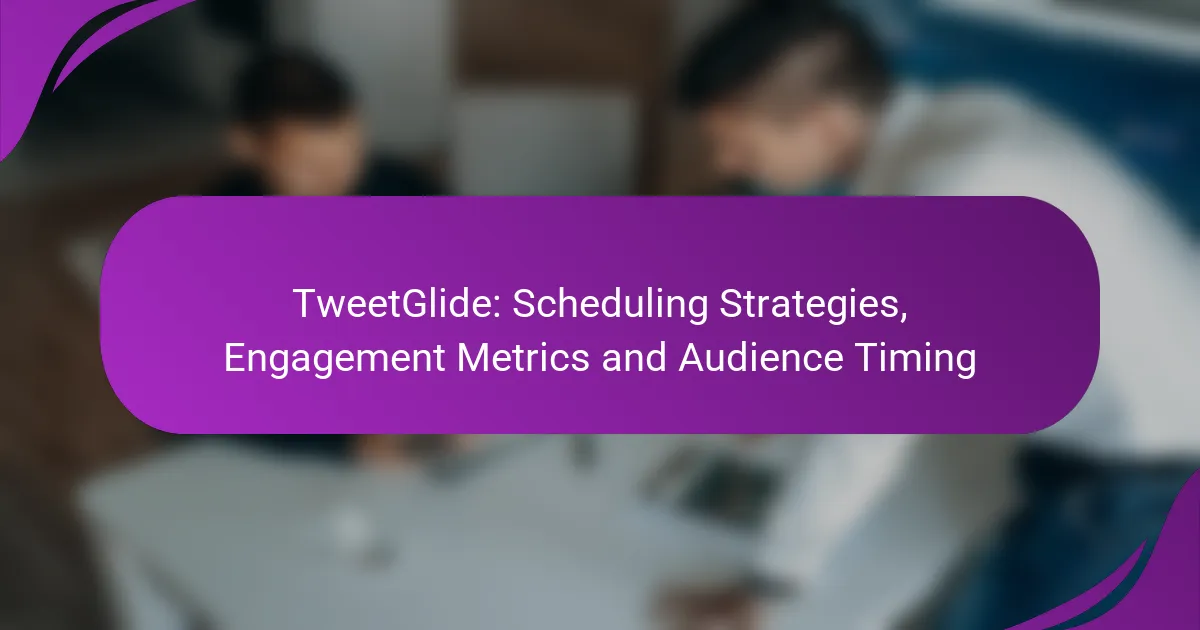Maximizing your Twitter presence with TweetGlide requires effective scheduling strategies that align with your audience’s peak engagement times. By leveraging automation tools and analyzing engagement metrics, you can tailor your content to resonate more deeply with your followers. Understanding the optimal timing for posts is essential for enhancing visibility and interaction, particularly within the Canadian market.
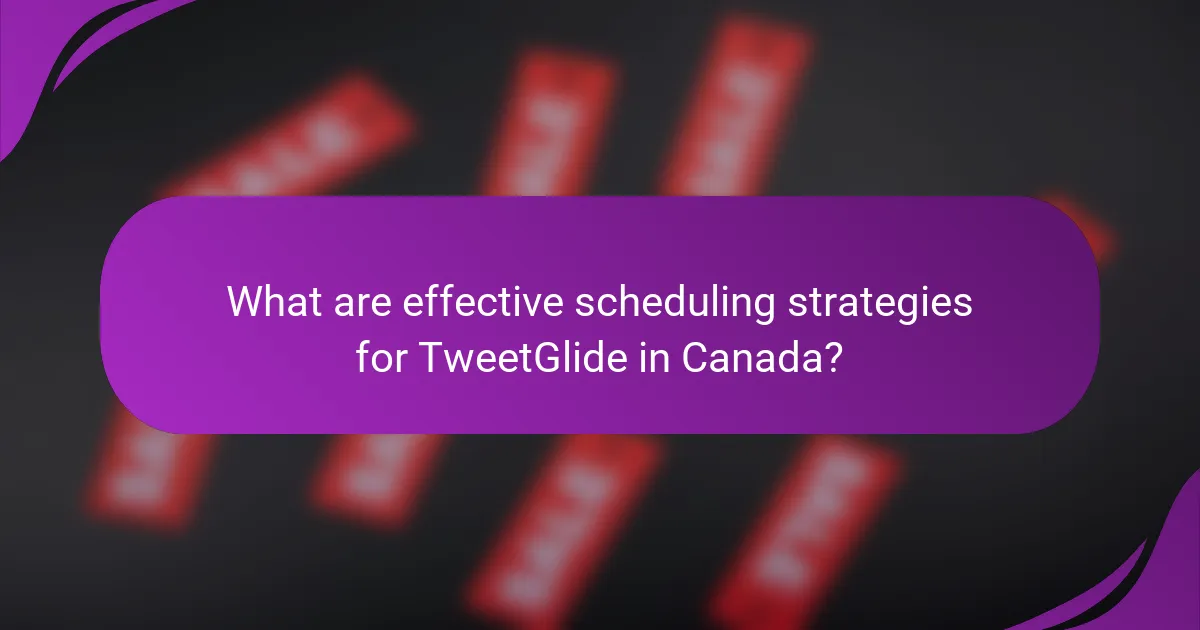
What are effective scheduling strategies for TweetGlide in Canada?
Effective scheduling strategies for TweetGlide in Canada involve understanding peak engagement times and utilizing automation tools to streamline posting. By aligning your content with when your audience is most active, you can significantly enhance visibility and interaction.
Optimal posting times for Canadian audiences
To maximize engagement, consider posting during early mornings and late afternoons on weekdays, as these times often see higher user activity. Research indicates that the best days for engagement are typically Tuesday through Thursday, with peak times around 11 AM to 1 PM and 5 PM to 7 PM.
Monitor your audience’s behavior using TweetGlide’s analytics to refine your posting schedule. Adjustments based on real-time data can lead to improved interaction rates, ensuring your content reaches users when they are most likely to engage.
Content calendar best practices
Creating a content calendar is essential for maintaining a consistent posting schedule. Plan your content at least a month in advance, incorporating seasonal events and relevant trends that resonate with Canadian audiences. This foresight allows for timely and relevant posts that can capture attention.
Include a mix of content types, such as promotional posts, informative articles, and engaging questions. This variety keeps your audience interested and encourages interaction. Regularly review and adjust your calendar based on performance metrics to optimize future posts.
Automation features of TweetGlide
TweetGlide offers several automation features that can enhance your scheduling efficiency. Use the auto-scheduling tool to post at optimal times without manual intervention, allowing you to focus on content creation rather than timing.
Additionally, set up recurring posts for evergreen content to ensure consistent visibility. However, avoid over-automation; regularly engage with your audience in real-time to maintain a personal connection and respond to comments or inquiries promptly.

How can engagement metrics improve my TweetGlide strategy?
Engagement metrics can significantly enhance your TweetGlide strategy by providing insights into how your audience interacts with your content. By analyzing these metrics, you can tailor your tweets to better resonate with your followers, ultimately increasing your reach and effectiveness on the platform.
Key performance indicators for Twitter engagement
Key performance indicators (KPIs) for Twitter engagement include likes, retweets, replies, and mentions. These metrics help you gauge how well your content is resonating with your audience. Aiming for a balanced mix of these indicators can provide a comprehensive view of your engagement levels.
For example, a tweet that receives a high number of retweets but few replies may indicate that while the content is shareable, it may not be prompting conversation. Tracking these KPIs over time can reveal trends and patterns in audience behavior.
Analyzing audience interactions
To effectively analyze audience interactions, consider using tools that aggregate data on your tweets’ performance. Look for patterns in the types of content that generate the most engagement, such as images, videos, or polls. This analysis can help you identify what resonates best with your followers.
Additionally, pay attention to the timing of interactions. Noting when your audience is most active can guide you in scheduling your tweets for maximum visibility and engagement. Tools like TweetGlide can assist in this analysis by providing insights into optimal posting times.
Adjusting strategies based on metrics
Adjusting your strategies based on engagement metrics involves a continuous cycle of testing and refining your approach. If certain types of content consistently underperform, consider revising your messaging or format. For instance, if tweets with images receive higher engagement, prioritize visual content in your strategy.
Moreover, regularly reviewing your metrics allows you to stay agile in your approach. Set aside time each month to evaluate your performance and make necessary adjustments. This proactive stance can help you maintain relevance and connection with your audience over time.
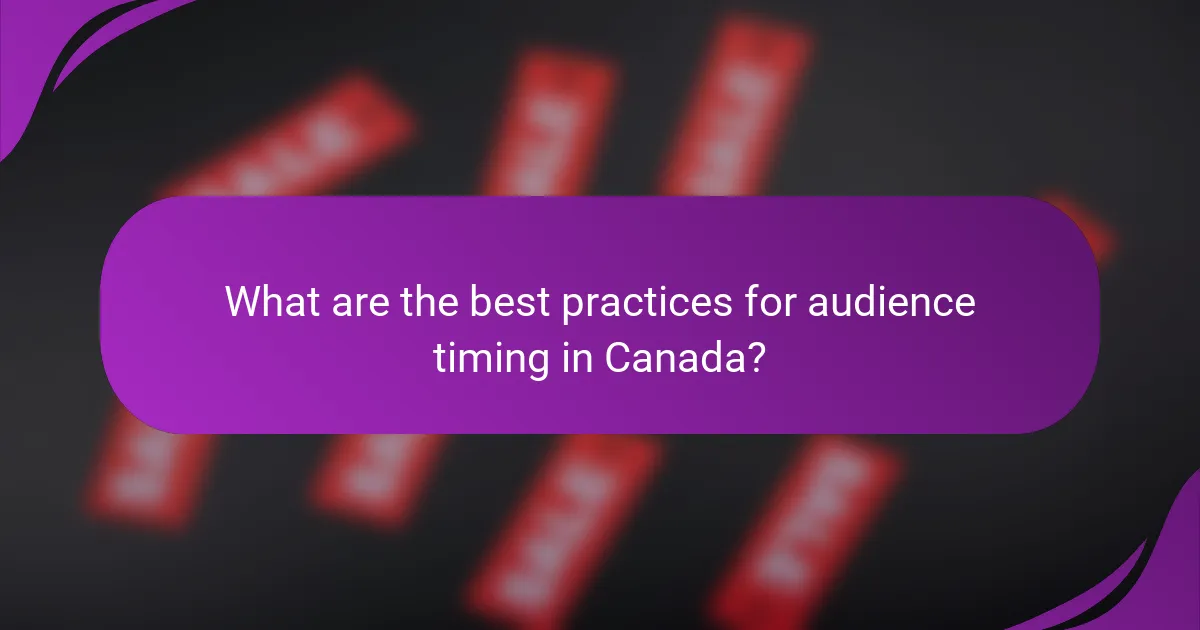
What are the best practices for audience timing in Canada?
To effectively engage Canadian audiences on Twitter, it’s crucial to understand the optimal timing for posting. This involves analyzing peak engagement hours, demographic insights, and regional behaviors to maximize visibility and interaction.
Understanding peak engagement hours
Peak engagement hours on Twitter in Canada typically fall during weekday afternoons and evenings. Users are most active between 12 PM and 3 PM, as well as from 5 PM to 8 PM, aligning with lunch breaks and post-work hours.
Scheduling tweets during these high-traffic times can significantly increase the likelihood of user interaction. Consider using scheduling tools to automate posts for these peak periods, ensuring your content reaches the audience when they are most active.
Demographic insights for Canadian Twitter users
Canadian Twitter users span various demographics, with a notable presence among younger audiences aged 18 to 34. This group tends to engage more frequently during evenings and weekends, making these times ideal for targeting content aimed at younger users.
Understanding the interests and behaviors of different age groups can help tailor your messaging. For instance, content related to entertainment or current events may resonate more with younger users, while professional or educational topics might engage older demographics.
Regional variations in audience behavior
Audience behavior on Twitter can vary significantly across Canada’s provinces. For example, users in urban areas like Toronto and Vancouver may have different peak times compared to those in rural regions, where engagement might be more consistent throughout the day.
Consider local events and holidays that could influence user activity. For instance, tweets related to sports events or local festivals may see higher engagement during those specific times. Tailoring your strategy to regional preferences can enhance your overall engagement rates.

What criteria should I consider when choosing a scheduling tool?
When selecting a scheduling tool, consider integration capabilities, pricing models, and user-friendliness. These factors will significantly impact your ability to streamline social media management and enhance engagement.
Integration capabilities with other platforms
Integration capabilities are crucial for a scheduling tool, as they determine how well it connects with other platforms you use, such as social media networks, analytics tools, and content management systems. Look for tools that support seamless integration with popular platforms like Facebook, Twitter, Instagram, and LinkedIn.
Additionally, check if the scheduling tool can connect with analytics services to track performance metrics. This will allow you to analyze engagement and adjust your strategies accordingly. Tools that offer API access can also provide greater flexibility for custom integrations.
Pricing models of scheduling tools
Pricing models for scheduling tools can vary widely, typically falling into subscription-based or one-time payment categories. Subscription models often offer tiered pricing based on features, user numbers, or the volume of posts, ranging from low monthly fees to higher costs for advanced features.
When evaluating pricing, consider your budget and the specific features you need. Some tools may offer free trials or basic plans that can help you assess their value before committing to a paid plan. Always compare what each pricing tier includes to ensure you get the best return on investment.
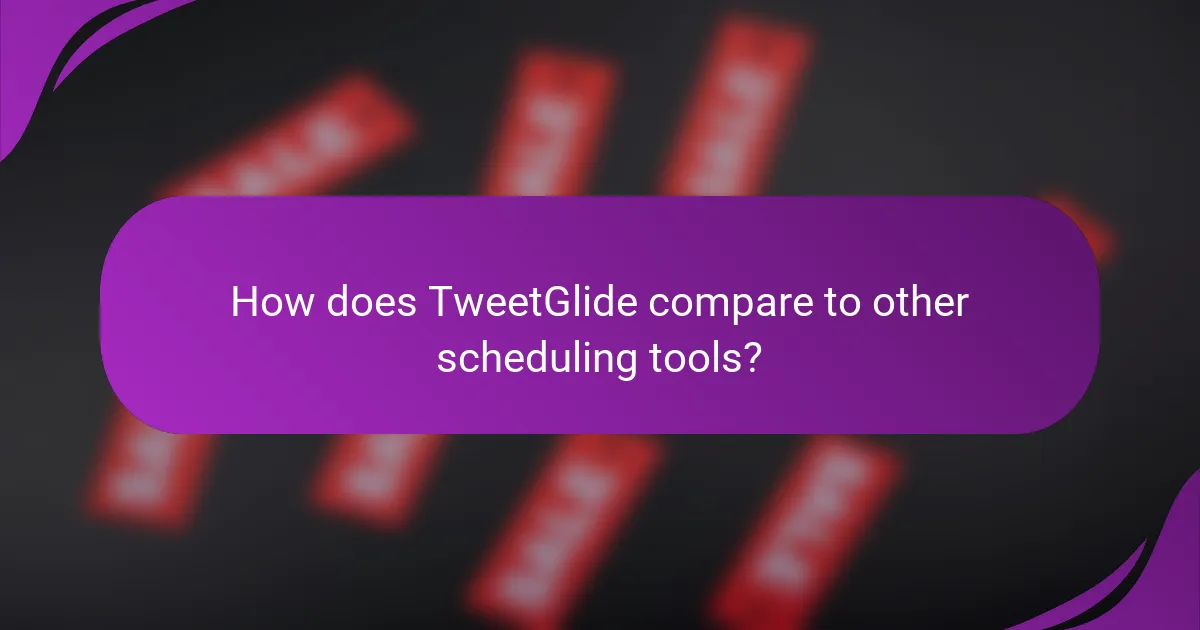
How does TweetGlide compare to other scheduling tools?
TweetGlide stands out among scheduling tools for its user-friendly interface and robust analytics features. It offers unique capabilities in audience engagement and optimal posting times, making it a strong contender against established platforms like Hootsuite and Buffer.
TweetGlide vs. Hootsuite
TweetGlide and Hootsuite both provide comprehensive scheduling options, but TweetGlide excels in its real-time engagement metrics. Users can track interactions and adjust their strategies quickly, while Hootsuite offers a broader range of social media platforms but may lack the same depth in Twitter-specific analytics.
For example, TweetGlide’s audience timing feature allows users to identify peak engagement hours based on historical data, which can significantly enhance post visibility. Hootsuite, while powerful, requires more manual input to achieve similar insights.
TweetGlide vs. Buffer
When comparing TweetGlide to Buffer, the key difference lies in their approach to scheduling. Buffer is known for its simplicity and ease of use, making it ideal for beginners. However, TweetGlide provides more advanced features for seasoned users, such as detailed engagement metrics and customizable scheduling options.
Buffer allows users to set a posting schedule but lacks the in-depth audience analysis that TweetGlide offers. This can be a disadvantage for users looking to maximize their engagement on Twitter. For effective use, consider your level of expertise and the specific analytics you need when choosing between the two.

What are advanced features of TweetGlide for power users?
TweetGlide offers advanced features tailored for power users, enhancing their ability to manage and analyze Twitter engagement effectively. Key functionalities include custom analytics dashboards and advanced audience segmentation, which provide deeper insights and targeted outreach strategies.
Custom analytics dashboards
Custom analytics dashboards in TweetGlide allow users to visualize and track engagement metrics that matter most to their goals. Users can select specific KPIs, such as retweets, likes, and follower growth, to create a dashboard that reflects their unique performance indicators.
To set up a custom dashboard, navigate to the analytics section and choose the metrics you wish to monitor. This tailored approach helps in identifying trends and making data-driven decisions. Regularly reviewing these dashboards can lead to improved content strategies and audience engagement.
Advanced audience segmentation
Advanced audience segmentation enables users to categorize their followers based on various criteria, such as interests, demographics, and engagement levels. This feature allows for more targeted messaging and content delivery, increasing the likelihood of interaction.
To effectively utilize audience segmentation, consider creating segments based on past engagement behavior or specific interests. For instance, targeting segments that frequently engage with tech-related tweets can lead to higher engagement rates. Regularly updating these segments ensures that your messaging remains relevant and effective.
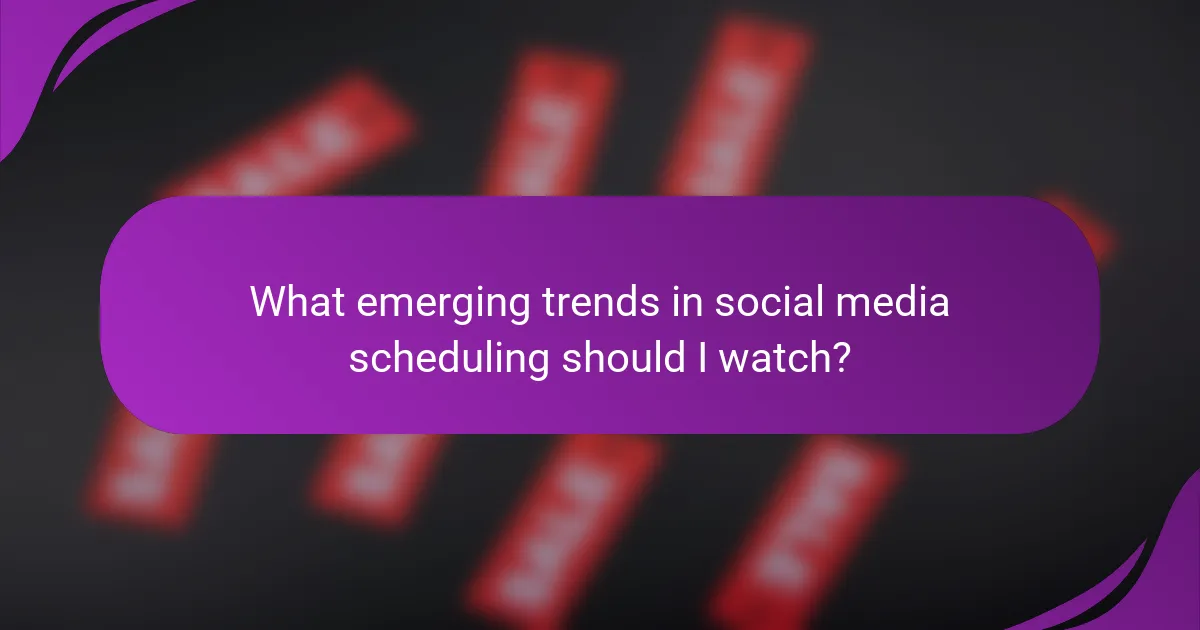
What emerging trends in social media scheduling should I watch?
Emerging trends in social media scheduling focus on automation, data-driven strategies, and audience engagement. Marketers are increasingly using advanced analytics to determine optimal posting times and tailor content to audience preferences.
Scheduling Automation Tools
Automation tools streamline the scheduling process, allowing users to plan posts in advance across multiple platforms. Popular tools like Hootsuite and Buffer enable marketers to set specific times for content to go live, ensuring consistent engagement without manual effort.
When choosing an automation tool, consider features such as analytics integration, user-friendliness, and platform compatibility. These factors can significantly impact the effectiveness of your social media strategy.
Data-Driven Engagement Metrics
Engagement metrics are crucial for assessing the effectiveness of your social media posts. Key metrics include likes, shares, comments, and click-through rates, which provide insights into audience interaction and content performance.
Regularly analyzing these metrics helps identify trends and informs future content strategies. Aim to track engagement over time to understand what resonates with your audience and adjust your approach accordingly.
Optimal Audience Timing
Understanding optimal audience timing is essential for maximizing reach and engagement. Research suggests that posting during peak hours, typically when users are most active, can lead to higher interaction rates.
Experiment with different posting times to find what works best for your specific audience. Tools like Sprout Social offer insights into when your followers are online, helping you schedule posts for maximum impact.
